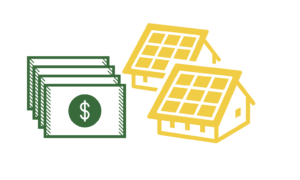How should I finance my solar system?
 One of the most common barriers homeowners face when deciding to go solar is the upfront investment it takes. The strength of the investment is easy for installers like Ecohouse to quantify, but still it takes money to complete.
One of the most common barriers homeowners face when deciding to go solar is the upfront investment it takes. The strength of the investment is easy for installers like Ecohouse to quantify, but still it takes money to complete.
In fact, that is one of solar’s great advantages: that by owning a small power plant, YOU the homeowner get to make money off of it, rather than buying power from the utilities, who own their power plants and make money off of them. Indeed, cash is king for any financial transaction, and can help speed the process while maximizing ROI. But if cash is short, there are a number of financing options that can help to make the deal come together and ease the cashflow burden. Let’s explore them one by one.
- Bank Loan
The State of Ohio Treasurer’s Office has a popular program called Eco-Link, which offers an interest rate reduction from a home improvement loan intended for energy efficiency and renewable energy projects such as solar. This reduction is worth up to 3% off the rate, and can include a balance up to twice the value of the energy project, in cases where other renovations are being made. The maximum loan amount is $50,000, and it is up to the borrower whether they choose to finance all or part of the project.
Loans may be secured by home equity for the best interest rate, or unsecured loans can work as well. The program is available for 5-year terms for most loans, however, a 7-year term is available for a Home Equity Loan that is greater than $25,000.
As these loans are low interest and shorter term, the total interest cost is fairly low. That is why it is a popular program and why it remains our #1 financing tool. It’s simply the best deal, even though it does require you the homeowner to make the application. Ask your Ecohouse representative to refer you to a banker who is experienced in dealing with the program.
- Contractor Financing
Solar installers often have access to private lenders that offer special loans for solar. These loans are often long-term, such as 20 years, and may offer an interest-only period until the customers tax credit is received to pay part of it down. The nice thing about a loan such as this is that it can be considered “$0 out-of-pocket,” meaning that the utility savings at least cover the loan payment, saving the customer money from Day 1. The downside of these loans is that they can be very expensive. Rates are at least 6%, and the lenders also require an upfront financing fee that is worth at least 12% of the project cost. Be careful, because most installers who deal in these loans do not disclose this fee; it is just wrapped into the project cost. Adding up these additional fees and interest payments over such a long time can make a substantial impact on the effective cost of the project, even more than double!
- Clean Energy Credit Union
In 2018, the American Solar Energy Society (ASES), opened a non-profit lending institution to offer an affordable alternative to private solar lending. Today, the Clean Energy Credit Union (CECU) offers a fixed rate for 12-year solar loans, without the significant closing fees a private bank might require. Up to 70% of the project can be financed, up to $50,000. Additionally, there is an 18-month balloon loan option for the tax credit portion of the job (up to 30%), so that the customer doesn’t have to be “cash poor” while they wait for next year’s tax return. Since most solar projects pay for themselves with utility savings in about the same timeframe, these loans can still be considered “$0 out-of-pocket,” simply swapping most of the utility bill for the loan payment. Borrowing does require becoming a member of ASES, for a minimum $25 membership fee.
- Combinations
With any lending option, it is up to the customer how much of the project cost should be financed. In many cases, some amount will be put down (for instance, 30%), in order to lower the payments required. Other times, it may make sense to wrap 100% of the cost into an Eco-Link loan for a low rate, and when the tax credit is returned to the owner, that money may be used to pay off other higher-interest debt, or simply the solar loan itself. With the balloon loan option from CECU (no payments due until the end of the 18-month term), one could foreseeably reduce their payments by deferring 30% to this program, and still financing 70% through the low-interest Eco-Link program.
- Deferred Payment
12 or 18 Months Same-As-Cash financing can seem like a win-win. After all, would you rather pay now, or pay later? The truth is, this is another form of contractor financing, where the contractor pays fees to offer the lending, which increases his costs anyhow. These programs exist to make sales easier, but they don’t make things cheaper for the customer. Also, you should be careful that you have enough cash to pay off the loan in full after the initial period, because interest will accrue like a credit card if there is still a balance.
- Leasing
Solar leasing has been used around the country for solar systems, so that customers can enjoy the benefits of the system, without having to incur either the upfront expense or the debt. While that seems like an attractive proposition, lease terms can be as expensive as a long-term loan, and furthermore disqualify you from receiving the federal tax credit. Also, if you were to sell your home, because you do not own the system, a leased system would be seen as a liability to the buyer, not an asset, therefore decreasing the price rather than providing you with value. Because of this, leased systems have become less common in the industry, and they are not offered by Ecohouse.
Owning a solar array can be a great investment in your home. Although there are banks willing to partner with you to make this investment easier, do your homework before signing up for anything, especially with a 20-year loan! If you are not ready to make the purchase, it may just make the most sense to save up for a little while until the time is right.







